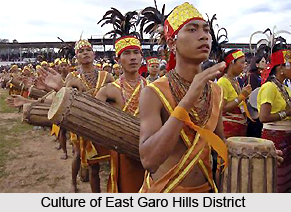 Culture of East Garo Hills District is mainly influenced by the indigenous traditions and beliefs of the tribal people. Garos comprise the majority of the population in this district of Meghalaya. Other tribal groups constituting the population of East Garo Hills District include the Rabha tribe, Hajongs, Koches, Dalus and Bodo tribe. Garos use a language that belongs to the Bodo branch of the Bodo-Naga-Kachin family. The various dialect groups that comprises the Garos are the Ambeng, Atong, Akawe (or Awe), Duals, Matchi, Matabengs, Chibok, Chisak Megam or Lyngngam, Ruga, Gara-Ganching. The Garos of the hills practice slash-and-burn agriculture or jhum-cultivation while the Garo of the plains practice wet-rice agriculture.
Culture of East Garo Hills District is mainly influenced by the indigenous traditions and beliefs of the tribal people. Garos comprise the majority of the population in this district of Meghalaya. Other tribal groups constituting the population of East Garo Hills District include the Rabha tribe, Hajongs, Koches, Dalus and Bodo tribe. Garos use a language that belongs to the Bodo branch of the Bodo-Naga-Kachin family. The various dialect groups that comprises the Garos are the Ambeng, Atong, Akawe (or Awe), Duals, Matchi, Matabengs, Chibok, Chisak Megam or Lyngngam, Ruga, Gara-Ganching. The Garos of the hills practice slash-and-burn agriculture or jhum-cultivation while the Garo of the plains practice wet-rice agriculture.
Garo society is principally matrilineal. Inheritance of property among the Garos is generally linked with matrimonial relations. People belonging to the Garo tribal community live in semi-permanent villages varying in size from 10 to 60 houses. Village populations rarely exceed 300. Historically, the Garos did not own land - whatever land they hold in possession, they do so without any ownership documents and the land belonged to the tribe as a collective property, cultivated under a cooperative system. Among the hill Garos, all subsistence is based on jhum cultivation. Dry rice is the primary crop, and millet is also important. In addition, bananas, papaya, maize, manioc, taro, squash, large-pod beans, sorrel, gourds, and many other vegetables are grown to supplement the diet. Important cash crops are cotton, chili peppers, and ginger.
Religious and traditional beliefs of Garo tribe heavily influence the culture of East Garo Hills District. Garos traditionally follow their own religion known as Songsarek. They also have a belief system with an underlying principle of fear and dread of the supernatural powers. Appropriate sacrifices are offered to them as occasions demand. In fact, in all religious ceremonies, sacrifices were essential for the propitiation of the spirits. The Garos also show reverence to their ancestors by offering food to the departed souls and by erection of memorial stones. Like other religions, the Songsarek religion ascribes to every human being the possession of a spirit that remains with him throughout his lifetime and leaves the body at death.
Garos normally do use many ornaments. The basic ornaments used by them are string of beads and earring (worn both by men and women). Culture of East Garo Hills District also includes festivals, celebrations, songs and dance performaces. Interestingly, there are no organized games as such among the Garos. However, games are generally played occasionally. The common and regular festivities are, of course, those connected with agricultural operations. Biggest Garo festival is `Wangala` which is more a celebration of thanksgiving after harvest. There is no fixed date for the celebration, it varies from one village to another, but usually, Wangala is celebrated in October. Preparations start well in advance. Dance performances add more charm to the entire celebration of this festival.






